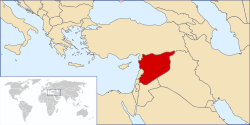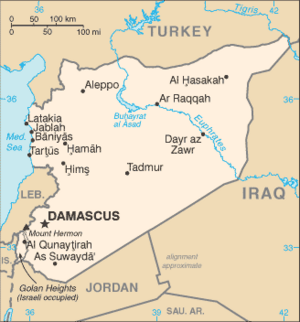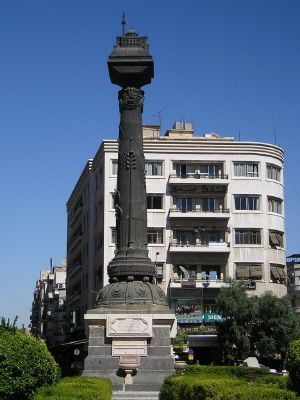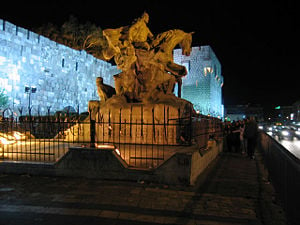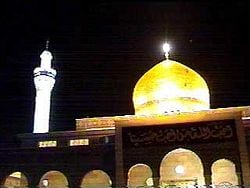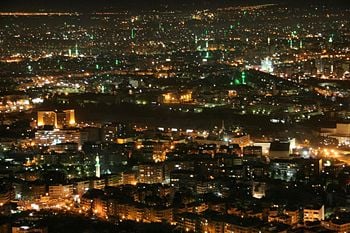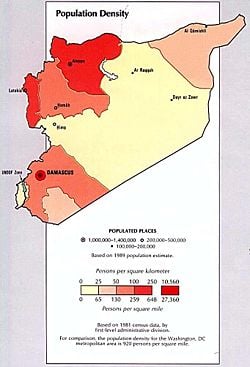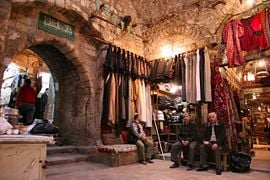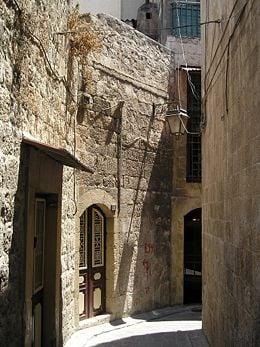Syria
| الجمهورية العربية السورية Al-Jumhūriyyah al-ʿArabiyyah as-Sūriyyah Syrian Arab Republic |
||||||
|---|---|---|---|---|---|---|
|
||||||
| Anthem: Homat el Diyar Guardians of the Land |
||||||
| Capital | Damascus | |||||
| Largest city | Aleppo[1] | |||||
| Official languages | Syrian Arabic1 | |||||
| Demonym | Syrian | |||||
| Government | Dominant-party system | |||||
| - | President | Bashar al-Assad | ||||
| Legislature | People's Council | |||||
| Independence | ||||||
| - | From France | 17 April 1946 | ||||
| Area | ||||||
| - | Total | 185,180 km² (88th) 71,479 sq mi |
||||
| - | Water (%) | 1.1 | ||||
| Population | ||||||
| - | 2011 estimate | 22,457,763[2] (53rd) | ||||
| - | Density | 118.3/km² (101st) 306.5/sq mi |
||||
| GDP (PPP) | 2010 estimate | |||||
| - | Total | $105.238 billion[3] | ||||
| - | Per capita | US$5,043[3] | ||||
| GDP (nominal) | 2010 estimate | |||||
| - | Total | US$60.210 billion[3] | ||||
| - | Per capita | US$2,958[3] | ||||
| Currency | Syrian pound (SYP) |
|||||
| Time zone | EET (UTC+2) | |||||
| - | Summer (DST) | EEST (UTC+3) | ||||
| Internet TLD | .sy, سوريا. | |||||
| Calling code | [[+9632]] | |||||
| 1 | Arabic is the official language; spoken languages and varieties are: Syrian Arabic, North Mesopotamian Arabic, Kurmanji Kurdish, Armenian, Aramaic, Circassian, Turkish[4] | |||||
| 2 | 02 from Lebanon | |||||
Syria, officially the Syrian Arab Republic is a Middle Eastern country bordering the Mediterranean Sea and Lebanon to the west, Israel to the southwest, Jordan to the south, Iraq to the east, and Turkey to the north.
Considered one of the original "Cradle of Civilization" states, the modern state of Syria can trace its roots to the fourth millennium B.C.E. Syrian scholars and artists contributed to Hellenistic and Roman thought and culture. Its capital city, Damascus, was the seat of the Umayyad Empire and a provincial capital of the Mamluk Empire.
Because of its strategic geographic location, Syria has historically been a focus of transit trade among many countries of the Middle East and is a vital factor in Arab politics and in Arab-Israeli hostilities.
Since 1963 the country has been governed by the Baath Party, and Syria's president in 2007 was Bashar al-Assad, son of Hafez al-Assad, who held office from 1970 until his death in 2000. A republic under an authoritarian military-dominated regime, Syria suffers from human rights abuses and a high poverty rate.
Geography
The name "Syria" comes from the ancient Greek name for the Syrians “Syrioi,” a shortened form of “Assyria,” which ultimately came from the Akkadian "Assur."
Syria borders the Mediterranean Sea and Lebanon to the west, Israel to the southwest, Jordan to the south, Iraq to the east, and Turkey to the north.
Land area is 71,749 square miles (183,885 square kilometers), which is slightly larger than the state of North Dakota in the United States. This does not include the Golan Heights, where in 2007 there were 42 Israeli settlements and civilian land-use sites. The territory, which consists of deserts, plains, and mountains, does not coincide with ancient Syria, which was the strip of fertile land between the eastern Mediterranean coast and northern Arabia.
The lowest point is an unnamed location near Lake Tiberias, at 656 feet (200 meters) below sea level, and the highest point is Mount Hermon at 9232 feet (2814 meters) above sea level.
Syria consists mostly of an arid plateau, divided into a coastal zone—with a narrow, double mountain belt enclosing a depression in the west—and a much larger eastern plateau. Fertile land is the nation's most important natural resource, and efforts have been made to increase the amount of arable land through irrigation projects. The northeast of the country "Al Jazira" and the South "Hawran" are important agricultural areas.
The country is home to drought–resistant plants including myrtle, boxwood, and wild olive. Remote areas have wolves, hyenas, and foxes, while the desert has lizards, eagles, and buzzards.
Mostly desert, Syria has hot, dry, sunny summers (June to August), and mild, rainy winters (December to February) along the coast, and cold weather with snow or sleet periodically in Damascus. The temperatures at Damascus range from 40°F (4.4°C) in January to 100°F (37.7°C) in July and August. Three-fifths of the country has less than 10 inches (250mm) of rain a year.
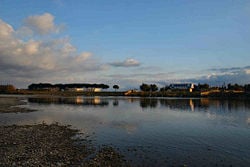
The most important river is the Euphrates, which represents more than 80 percent of Syria's water resources, and which rises in Turkey. Its left-bank tributaries, the Balikh and the Khabur, are both major rivers and also rise in Turkey. The right-bank tributaries are small seasonal streams called wadis. In 1973, Syria completed construction of the Tabaqah Dam on the Euphrates River, creating a reservoir named Lake Assad, a body of water about 50 miles (80km) long and averaging eight kilometers in width.
Natural resources include petroleum, phosphates, chrome and manganese ores, asphalt, iron ore, rock salt, marble, gypsum, and hydropower.
Natural hazards include sand storms and dust storms. Environmental issues include deforestation, overgrazing, soil erosion, desertification, water pollution from raw sewage and petroleum refining wastes, and inadequate drinking water.
Damascus, also commonly known as “ash-Shām” is the capital and largest city, and had a population of about 4.5 million in 2007. The city is a Governorates by itself, and the capital of the Governorates of Rif Dimashq (Rural Damascus). Other main cities are Aleppo in the north, and Homs. Most of the other important cities are located along the coastline.
History
Archaeologists have demonstrated that civilization in Syria was one of the most ancient on earth. Excavations at Tell Ramad, on the outskirts of Damascus, have demonstrated that this area has been inhabited as early as 8000 to 10,000 B.C.E. It is due to this that Damascus is considered to be among the oldest continually inhabited cities in the world.
Ebla
Around the excavated city of Ebla in northern Syria, discovered in 1975, a great Semitic empire spread from the Red Sea north to Turkey and east to Mesopotamia from 2500 to 2400 B.C.E. Ebla appears to have been founded around 3000 B.C.E. and gradually built its empire through trade with the cities of Sumer and Akkad, as well as with peoples to the northwest. Gifts from Pharoah found during excavations confirm Ebla's contact with Ancient Egypt. Scholars believe the language of Ebla to be among the oldest known written Semitic languages.
At Ebla (Tel Merdikh), a royal palace was discovered containing one of the largest and most comprehensive archives of the ancient world. Ebla's archive consists of more than 17,000 clay tablets dealing with matters of industry, diplomacy, trade, art and agriculture. Ebla became world-famous for two industries: the manufacture of finely carved wood, inlaid with ivory and mother of pearl; and of silk cloth of gold. Today these industries still prosper, with Syrian brocade and mosaics fashioned according to the artisan tradition of ancient Ebla.
The Eblan civilization was likely conquered by Sargon of Akkad around 2260 B.C.E. The city was restored as the nation of the Amorites a few centuries later and flourished through the early second millennium B.C.E. until conquered by the Hittites.
Other notable cities excavated include Mari, Ugarit and Dura Europos. At Mari (Tel Hariri) numerous palaces, temples and murals were found that reflect advanced cultural and commercial activity. The kingdom of Ugarit (Ras Shamra) offered humankind its first alphabet. Syria was occupied successively by Canaanites, Hebrews, Arameans, Assyrians, Babylonians, and Persians.
Hellenistic era
Alexander the Great added Syria to his empire in 333 B.C.E., and one of his generals, Seleucus I, who founded Antioch in Ancient Syria (located in Turkey in 2007), continued Greek rule. The area, and much of western Asia, passed to the Seleucids under Antiochus III and Antiochus IV, and became known as the kingdom of Syria. Gradually, Seleucid authority was limited to Damascus and Antioch, as Nabataeans and Jews feuded over the remainder.
After the decline of the Seleucid Empire, a Hellenistic Armenian state was founded in 190 B.C.E., with Artaxias becoming its first kings and the founder of the Artaxiad dynasty (190 B.C.E. - 1 C.E.). For a time, Armenia was one of the most powerful states in the Roman East. It eventually confronted the Roman Republic in a war, which it lost in 66 B.C.E., but nonetheless preserved its sovereignty.
Pompey the Great made Syria a Roman province in 64 B.C.E. According to the Bible, Paul was converted on the Road to Damascus and joined the first organized Christian Church in Antioch, from which he left on many of his missionary journeys. Syria remained a peaceful and important province, and absorbed the Nabataean kingdom in 106 C.E. The great city of Antioch (it was called the Athens of the east) was the capital of Syria and with a total estimated population of 500,000, the city was one of the largest centers of trade and industry in the ancient world. Queen Zenobia of the ancient city of Palmyra took leadership and led her people against Roman troops in 297 C.E.
After the Roman Empire was divided in 395 C.E., Syria remained a Byzantine province for 240 years. The Sassanian king Khosrau I captured Antioch in 570, and Khosrau II invaded in 606, only to be expelled after 622 by Heraclius.
Islamic era
Arabs conquered Syria in 636, and it was quickly absorbed into the expanding Islamic caliphate. Damascus came under Muslim rule in 636 C.E. Immediately thereafter the city's power and prestige reached its peak and it became the capital of the Umayyad Empire, which extended from Spain to the borders of Central Asia from 661 to 750. Syria acted as a cultural hub that took in influences from many sources and sent them out to other parts of the empire and Damascus achieved a glory unrivalled among cities of the eighth century. The Umayyads were overthrown by the Abbasid dynasty in 750, and the seat of the Abbasid caliphate was established at Baghdad, Iraq.
Beginning in 1095, Syria was a target of the Crusades, and sections of the coastline of Syria were briefly held by Frankish overlords in the twelfth century. Damascus became a provincial capital of the Mamluk Empire around 1260. In the thirteenth century, the first Mongols arrived, destroying cities and irrigation works. Tamerlane, the Mongol conqueror, moved many Damascus craftsmen to Samarkand. By the end of the fifteenth century, the discovery of a sea route from Europe to the Far East ended the need for an overland trade route through Syria. In 1517, Syria fell under the Ottoman Empire, which remained from the sixteenth through twentieth centuries, except for a brief occupation by Ibrahim Pasha of Egypt from 1832 to 1840.
In World War I, the Ottoman Empire sided with the Central Powers. In 1916, to enlist support against Turkey, the Allied nations of England and France offered anti-Turkish Arabs the hope of independence, while secretly concluding the Sykes-Picot agreement, by which most of the Arab lands under Turkish rule were to be divided between Britain and France.
French mandate
After World War I, the Ottoman Empire was dissolved, and in 1922 the League of Nations split the former Syria between England and France: England received Transjordan and Palestine, and France received what was to become modern-day Syria and Lebanon. In Syria, anti-Turkish sentiment changed to anti-French sentiment. The French put down an armed rebellion in 1920 and a second uprising that lasted from 1925 to 1927. French and Syrian leaders had reached agreement on substantial Syrian independence by 1938, but the French government refused to ratify the treaty. In 1939, France ceded to Turkey the former Turkish district of Alexandretta, in which the ancient Syrian capital of Antioch is located.
World War II broke out in 1939. After the surrender of France to Germany in 1940, Syria came under the control of the Vichy government. British and free French forces invaded Syria in 1941, and the Free French government recognized Syria’s independence, but the occupation continued. Elections in 1943 brought a new Syrian government under the presidency of the Syrian nationalist Shukri al-Kuwatli.
Independence
In 1946, the independence treaty of 1944 was recognized and French and British troops left Syria, the last leaving April 15, 1946. Independence was declared on April 17, which is commemorated each year as the Jalaa Day.
Political instability marked the post-war period. On March 30, 1949, General Husni al-Zaim, a member of the Kurdish minority, seized power, to be overthrown in August of that year by another military junta. Elections were held that November. A former police chief, led by Colonel Adib al-Shishakli, led a third coup that year. A further coup on November 29, 1951, led by Shishakli, resulted in a military dictatorship that lasted until March 1954, when he was ousted by another military group that reinstated Hashim al-Atasi as president, reconvened the 1949 chamber of deputies, and restored the constitution of 1950.
The 1948 Arab-Israeli War
In 1944, a “Greater Syria” movement began to push for a Syrian Arab state that would include Lebanon, Syria, Jordan, and Israel. Syria joined the Arab League, which was formed to prevent the creation of a Jewish state in Palestine. Syrian forces fought in the 1948 war between Arab forces and the new state of Israel. Syrian and Israeli frontier forces clashed in 1951 over an Israeli drainage project in the demilitarized zone between the two countries.
The Syrian government objected in 1955 to the creation of the Baghdad Pact, a defensive alliance between Turkey, Iraq, Iran, Pakistan, and Britain. Attacks on Egypt in 1956 by Israel, Britain, and France intensified the growing Syrian resentment towards the West. Syria denounced the 1957 Eisenhower Doctrine, designed to combat potential communist aggression in the Middle East. In September of 1957, Syria accused Turkey of massing troops on the border to carry out a U.S.-backed attack on Syria. The U.S.S.R. supported Syria, and the matter was brought before the United Nations General Assembly in October. The Soviet Union agreed to provide construction project aid to Syria over a period of 12 years.
Federation with Egypt
In February 22, 1958, Syria and Egypt merged as one state and created the United Arab Republic U.A.R., with Gamal Abdel Nasser of Egypt as president. Nasser appointed the U.A.R. cabinet, and Syrian politicians held a number of departments. In the following months Nasser dissolved all Syrian political parties. From September 1958 to February 1959 private agricultural farms and territories were nationalized and given to peasants. In July 1961, all private banks and factories were nationalized. In September 28, 1961, a group of army officers led by Karim an-Nahlawi seized power and declared Syria independent. Nasser decided not to resist the separatists.
Baath takeover
A new national government was set up in December 1961, to be overthrown in a bloodless military coup on March 8, 1963, by the Baath Party. Major-General Amin el-Hafez became chairman of the National Council, which was replaced, in May 1964, by a presidency council of three civilian and two military members. On February 23, 1966, a military coup lead by Hafez al-Assad and Salah Jadid, both members of the Baath party, forced Amin Hafez to resign, placed several long-time Baathist leaders under arrest, and installed Nur ad-Din al-Atasi, a former deputy prime minister, as head of state.
During 1966 and early 1967, Syrian-based guerrilla attacks and Israeli reprisals catalyzed a chain of events leading to the outbreak of the Six-Day War between Israel and the Arab nations in 1967. Israeli forces overran the Syrian positions on the Golan Heights, advanced rapidly, and occupied al-Qunaytirah, only 40 miles (65km) from Damascus. On June 10, the U.N. ceasefire proposal was accepted and observers were placed between Israeli and Syrian forces. Syria broke relations with Great Britain and the United States.
Assad seizes power
In November 1970 General Hafez al-Assad seized power. Becoming president in March 1971, he formed a new Cabinet in December 1972. In October 1973, Syrian troops attacked Israel on the Golan Heights, while Egypt struck along the Suez Canal. Israel drove the Syrians from the Golan Heights and advanced to within 20 miles of Damascus. A ceasefire was agreed upon and both parties signed a disengagement agreement in May 1974, which provided for a neutral zone, patrolled by U.N. forces, and for the repatriation of prisoners of war.
As Egypt pursued a bilateral agreement with Israel, Syria linked with Jordan. In 1975, at the request of the Lebanese government, Syria intervened and became bogged down in the Lebanese Civil War, which continued until October 1990. Syria helped the Lebanese government to re-establish control. In 1980 Syria signed a 20-year cooperation treaty with the U.S.S.R. Israel annexed the Golan Heights in 1981. Syrian and Israeli forces clashed in 1982, when Israel invaded Lebanon.
Strife at home
A serious challenge arose in the late 1970s, from Sunni Muslims known as the Muslim Brotherhood who rejected the values of the secular Baath program and objected to rule by the Alawis, whom they consider heretical. In response to an attempted uprising by the brotherhood in February 1982, the government sent 12,000 troops to crush the opposition centered in the city of Hama. During the two weeks the city was under siege its infrastructure was devastated by artillery fire and many thousands of civilians were killed and wounded. In 1984, when Hafez al-Assad was hospitalized following a heart attack, his brother Rifaat al-Assad attempted to seize power using internal security forces under his control. Hafez managed to assert control and sent Rifaat into exile.
War
During the Iran-Iraq War (1980 to 1988) Syria sided with Iran and was thus isolated by the other Arab countries, with the exception of Libya. There have been accusations, mainly by the U.S. and Israel, that Syria served as a conduit for Iranian arms destined for Hezbollah in Lebanon. Britain broke diplomatic relations with Syria in 1986 and the U.S. imposed sanctions, both accusing Syria of sponsoring terrorism.
About 21,000 Syrian ground forces served with the anti-Iraq coalition in the Gulf War. Syria's 1991 participation against Saddam Hussein marked a watershed in Syria's relations both with other Arab states and with the West. Syria participated in the multilateral Middle East Peace Conference in Madrid in October 1991, and during the 1990s engaged in direct, face-to-face negotiations with Israel. These negotiations failed, and there have been no further Syrian-Israeli talks since President Hafez Al-Assad's meeting with then U.S. President Bill Clinton in Geneva in March 2000.
Assad’s son succeeds
Hafez al-Assad died of a heart attack on June 10, 2000, after 30 years in office. The People's Council amended the constitution, reducing the mandatory minimum age of the president from 40 to 34 years old, which allowed his son, Bashar al-Assad to be legally eligible for nomination by the ruling Baath party. On July 10, 2000, Bashar al-Assad was elected president by referendum in which he ran unopposed, garnering 97.29 percent of the vote.
Bashar Al-Assad promised political and democratic reform. Human rights activists became more outspoken during a period referred to as "Damascus Spring" (July 2000 to February 2001). Enthusiasm faded quickly as the government cracked down on civil forums and reform activists, but there was still a notable liberalization compared to the totalitarianism of Hafez. The lifting of bans on internet access, mobile telephones and the spread of computer technology has had a great impact on the previously isolated Syrian society, and the secret police's presence in society has been eased.
England's prime minister Tony Blair met Assad in November 2001 following terrorist attacks on the World Trade Center in New York. They discussed the war on terrorism but failed to reach an understanding. In May of 2002, the U.S. government added Syria to its “axis of evil” countries, which are believed to sponsor terrorism or have the ability to use weapons of mass destruction, as defined by President George W. Bush.
When the U.S.-led coalition invaded Iraq in March 2003, Syria avoided direct involvement, but tried to prevent an exodus of refugees into the country from neighboring Iraq. Syria opposed the Iraq War in March 2003, and bilateral relations with the U.S. swiftly deteriorated.
On February 14, 2005, Rafik Hariri, the former prime minister of Lebanon, was killed by a car bomb in Beirut. Many members of the Lebanese opposition and international observers alleged that Hariri was assassinated by Syria. In April 26, 2005, Syria withdrew all of its troops. On June 16, 2006, the defense ministers of Iran and Syria signed an agreement for military cooperation against what they called the "common threats" presented by Israel and the United States.
Government and politics
Syria operates as a republic under an authoritarian military-dominated regime. The Syrian constitution vests the Arab Baath Socialist Party with leadership and provides broad powers to the president. The president, approved by referendum for a seven-year term (with no term limits), also is secretary general of the Baath Party and leader of the National Progressive Front, a coalition of approved political parties.
The president appoints the Council of Ministers, the vice presidents, the prime minister, and deputy prime ministers. The president can declare war and states of emergency, issue laws (which, except in the case of emergency, require ratification by the People's Council), declare amnesty, amend the constitution, and appoint civil servants and military personnel. Along with the National Progressive Front, the president decides issues of war and peace and approves the state's five-year economic plans.
The legislature consists of the 250-seat unicameral People's Council or Majlis al-Shaab. Members are elected by popular vote to serve four-year terms. Although parliamentarians may criticize policies and modify draft laws, they cannot initiate laws, and the executive branch retains ultimate control over the legislative process. It essentially functions as a rubber-stamp for the executive authority. Suffrage is universal to all aged 18 years and over.
Six other political parties are permitted to exist and, along with the Baath Party, make up the National Progressive Front, a grouping of parties that represents the sole framework of legal political party participation for citizens. While created ostensibly to give the appearance of a multi-party system, the National Progressive Front is dominated by the Baath Party and does not change the essentially one-party character of the political system. The National Progressive Front acts as a forum in which economic policies are debated and the country's political orientation is determined.
The judiciary comprises the Supreme Judicial Council, which appoints and dismisses judges, and which is headed by the president; the Supreme Constitutional Court, which adjudicates electoral disputes and rules on constitutionality of laws and decrees; justices, appointed for four-year terms by the president); the Court of Cassation; appeals courts, which are an intermediate level between the Court of Cassation and local courts; magistrate courts; courts of first instance; juvenile courts; customs courts; economic security courts; the Supreme State Security Court; and personal status courts, which hear cases related to marriage and divorce. The legal system is based on a combination of French and Ottoman civil law. Religious law is used in the family court system. Syria has not accepted compulsory International Court of Justice jurisdiction
Syria has 15 governoratess, each of which are divided into 60 districts, which are further divided into subdistricts. A governor, whose appointment is proposed by the minister of the interior, approved by the cabinet, and announced by executive decree, heads each governorates. The governor is assisted by an elected provincial council.
Human rights
A state of emergency has remained in effect since 1963 despite calls for its repeal. Since then, security forces have committed human rights abuses including arbitrary arrest and detention, prolonged detention without trial, unfair trials in the security courts, and infringement on privacy rights. Amnesty International estimates around 600 political prisoners remain.
Prison conditions do not meet international standards for health and sanitation. The regime restricts freedoms of speech, the press, assembly, association, and political opposition. In 2005 Freedom House rated political rights and civil liberties in Syria as “seven” (one representing the most free and seven the least free rating) and gave it the freedom rating of “Not Free” [three]. There have been no changes in these ratings since 1972.
Human Rights Watch World Report 2007 alleged that the human rights situation in Syria continued to deteriorate further in 2006, saying “thousands of political prisoners, many of them members of the banned Muslim Brotherhood and Communist Party remained in detention.” Syria continues to use the death penalty and Human Rights Watch has documented many instances of arbitrary detention, torture and disappearances in 2006.
Kurds continue to suffer discrimination and violence. At ten percent of the population, they form the largest ethnic minority group in Syria. An estimated 300,000 Syria born Kurds are still denied citizenship.
Muslim Brotherhood
The Muslim Brotherhood is a world-wide Sunni Islamist movement founded by the Sufi schoolteacher Hassan al-Banna in 1928. Since its inception, the movement has officially opposed violent means to achieve its goals, with some exceptions such as in the Israeli-Palestinian conflict or to overthrow secular Ba'athist rule in Syria. Created in Egypt, the Muslim Brotherhood became the first mass-based, overtly political movement to oppose the ascendancy of secular and Western ideas in the Middle East. The brotherhood saw in these ideas the root of the decay of Islamic societies in the modern world, and advocated a return to Islam as a solution to the ills that had befallen Muslim societies.
Military
The Syrian armed forces, comprising some 320,000 troops upon mobilization, is a conscripted force. Males serve 24 months in the military upon reaching the age of 18.
It has an arsenal of surface-to-surface missiles capable of reaching most of the populated areas of Israel, Syria's longstanding enemy in the region. In the early 1990s, Scud-C missiles with a 500-kilometer range were procured from North Korea, and Scud-D, with a range of up to 700km, is allegedly being developed by Syria with the help of North Korea and Iran. Syria received significant financial aid from Persian Gulf Arab states as a result of its participation in the Persian Gulf War, with a sizable portion of these funds earmarked for military spending. The Syrian armed forces consist of the Syrian Arab Army, Syrian Arab Navy, Syrian Arab Air Force, Syrian Arab Air Defense Forces, the police and the security force.
Economy
Syria is a middle-income, developing nation with a diversified economy based on agriculture, industry, and energy. During the 1960s, the socialist government nationalized most major enterprises and adopted economic policies designed to address regional and class disparities. This legacy of state intervention and state controls of prices, trade, and foreign exchange still hampers economic growth.
The Government of Syria cut lending interest rates, opened private banks, consolidated some of the multiple exchange rates, and raised prices on some subsidized items, most notably, gasoline and cement. Nevertheless, the economy remains highly government controlled. Economic constraints include declining oil production and exports, weak investment, high unemployment, and increasing pressure on water supplies caused by heavy use in agriculture, rapid population growth, industrial expansion, and water pollution.
Despite the recovery of energy export revenues, Syria's economy faces serious challenges. With almost 60 percent of its population under the age of 20, unemployment higher than the current estimated range of 20 percent to 25 percent is a real possibility unless sustained and strong economic growth takes off. Oil production has levelled off, but agreements allowing increased foreign investment in the petroleum sector may boost production.
About one-third of Syria’s land is arable, with 80 percent of cultivated areas dependent on rainfall for water. The agriculture sector has recovered from years of government inattentiveness and drought. Most farms are privately owned, but the government controls important elements of marketing and transportation.
Earnings from oil exports are one of the government's most important sources of foreign exchange. Exports totaled $6.923-billion in 2006. Export commodities included crude oil, petroleum products, fruits and vegetables, cotton fiber, clothing, meat and live animals, and wheat. Export partners included Iraq 26.3 percent, Italy 10 percent, Germany 9.9 percent, Lebanon 9.1 percent, Egypt 5.1 percent, France 4.9 percent and Saudi Arabia 4.6 percent.
The bulk of Syrian imports have been raw materials essential for industry, agriculture, equipment, and machinery. Imports totaled $6.634-billion. Import commodities included machinery and transport equipment, electric power machinery, food and livestock, metal and metal products, chemicals and chemical products, plastics, yarn, and paper. Import partners included Saudi Arabia 11.6 percent, China 6.1 percent, Egypt 5.9 percent, Italy 5.8 percent, United Arab Emirates 5.7 percent, Ukraine 4.6 percent, Germany 4.5 percent and Iran 4.2 percent.
Per capita Gross Domestic Product was $5348 in 2005, a rank of 101 on a list of 181 nations. About 11.9 percent existed below the poverty line.
Demographics
Syria had a population of 19 million in 2005. Most people live in the Euphrates River valley and along the coastal plain, a fertile strip between the coastal mountains and the desert. Overall population density is about 258 per square mile (99/km²). Life expectancy for the total population was 70.03 years in 2005.
Ethnicity
Most Syrians are an overall Semitic Levantine people. While modern-day Syrians are commonly described as Arabs by virtue of their modern-day language and bonds to Arab culture and history—they are in fact a blend of the various ancient Semitic groups indigenous to the region who in turn mixed with later arriving Arabs. There is also a smaller degree of admixture from non-Semitic peoples that have occupied the region over time. Arabs (including some 400,000 Palestinian refugees) make up over 90 percent of the population. The Kurds, linguistically an Indo-Iranian people, constitute the largest ethnic minority, making up about five percent of the population. Most Kurds reside in the northeast corner of Syria and many still speak the Kurdish language. Sizable Kurdish communities live in most major Syrian cities as well. The Assyrian Christians are also a notable minority (about three percent) that live in north and northeast Syria. Syria also holds the seventh largest Armenian population in the world. In addition, 1.2 million Iraqi refugees were living in Syria in 2007.
Religion
Syria's population is approximately 90 percent Muslim and 10 percent Christian. Among Muslims, 74 percent are Sunni; the rest are divided among other Muslim sects, mainly Alawis and Druze, but also a small number of non-Druze Isma'ili and Twelver Shi'a, which has increased dramatically due to the influx of Iraqi refugees. Christians, a sizable number of which are also found among Syrian Palestinians, are divided into several groups. Chalcedonian Antiochian Orthodox ("Greek Orthodox") make up 50 percent to 55 percent of the Christian population; the Catholics (Latin, Armenian, Maronite, Caldean, Melkite and Syriac) make up 18 percent; while Assyrian Christians, Armenian Oriental Orthodox centered in Aleppo, the native Syriac Orthodox Church and several smaller Christian groups account for the remainder. Christian Syrians are highly educated and mostly belong to a high socio-economic class. Their representation in the academic and economic life of Syria far exceeds their percentage of their population. There is a tiny Jewish community, remnants of a 40,000-strong community, that is confined mainly to Damascus. After the 1947 U.N. partition plan in Palestine, there were pogroms against Jews in Damascus and Aleppo. Jewish property was confiscated, or burned, and after the establishment of the State of Israel, many fled there. leaving only 5000 Jews in Syria. Of these, 4000 more left after agreement with the United States in the 1990s. As of 2006, there are only 100 to 200 Jews remained in Syria.
Languages
Syria offered the world the Ugarit cuneiform, the root for the Phoenician alphabet, which dates back to the fourteenth century B.C.E. The alphabet was written in the familiar order used today. Arabic was in 2007 the official and most widely spoken language. Kurdish is spoken in the Kurdish regions of Syria. Many educated Syrians also speak English or French, but English is more widely understood. Armenian and Türkmen are spoken among the Armenian and Türkmen minorities. Aramaic, the lingua franca of the region before the advent of Islam, and Arabic, are spoken among certain ethnic groups. Modern Aramaic (particularly, Turoyo language and Assyrian Neo-Aramaic) is spoken in the Al-Jazira region. Most remarkably, Western Neo-Aramaic is still spoken in the village of Ma`loula, and two neighboring villages, 35 miles (56 km) northeast of Damascus.
Men and women
The Baath Party was one of the first political groups in the Arab world to state that the emancipation and equal treatment of women was among its goals. But, while women became entitled to receive the same education as men and to seek work, they are still regarded as inferior. Within marriage, women are treated as their husband’s chattel. A woman is identified as her father's daughter until marriage, and after the birth of a male child, she is the mother of her son rather than the wife of her husband. Urban wives run the household and are restricted to the home, while rural women work in the fields as well as running the household. There have been no changes to laws that discriminate against women. For example, a judge may suspend punishment for a rapist if he marries his victim. Men enjoy going out to coffeehouses to talk, drink tea or Turkish coffee, and smoke sweetened tobacco through a “hubble-bubble” or water pipe (hookah). Sometimes they play board games, cards or chess.
Marriage and the family
Under Islamic tradition, the couple's families arrange any marriage, and it is rare for a couple to marry against their family's wishes. Despite opposition, the dowry system persists, placing immense pressure on the husband and his family, who have to pay large amounts of money, and on the bride, who may be forced to marry the suitor who brings the biggest dowry. Regarding polygamy, in 1953 Syria passed the Law of Personal Status, which required a man to demonstrate that he could support two wives before marrying the second one. Court proceedings are now required for divorce.
The family is the basic unit of society, and the father or grandfather has authority and is responsible for providing for the family. Several generations live in the same house. Property and social position passes to the oldest son. Clan ties influence the political system. Children are regarded as a blessing from God, as children can work in the fields and take care of their aged parents.
Education
Education is free and compulsory from ages six to 11. Schooling consists of six years of primary education followed by a three-year general or vocational training period and a three-year academic or vocational program. The second three-year period of academic training is required for university admission. Most schools are run by the state, and combine a French structure with traditional Islamic rigid discipline and rote learning. There are religious schools, United Nations relief schools, and Palestinian Refugee schools. Syria has vocational and teacher-training education as well as universities in Damascus, Aleppo, and Latakia. The literacy rate of Syrians aged 15 and older was 76.9 percent for the whole population in 2003.
Class
Syrian society has always been very stratified. Class lines have coincided with racial differences, with lighter-skinned people holding higher economic and political positions. Landholders and merchants traditionally occupied the highest position socially and politically, and lived in Damascus or Aleppo. Religious teachers were influential, serving as judges, teachers, and political officials.
Since the Baath takeover, army officers have become the new elite, while increased education resulted in a growing middle class. Some peasants moved to the cities and joined the middle class, while others own land, but there are still numerous landless peasants. The wealthy and well educated enjoy many of the trappings of Western life—televisions and radios, air conditioners, dishwashers, and microwaves.
Culture
Syria is a traditional society with a long cultural history. Archaeologists have discovered extensive writings and evidence of a culture rivaling those of Mesopotamia and Egypt in and around the ancient city of Ebla. Later Syrian scholars and artists contributed to Hellenistic and Roman thought and culture. Cicero was a pupil of Antiochus of Ascalon at Athens; and the writings of Posidonius of Apamea influenced Livy and Plutarch. Philip Hitti, Professor of Semitic Literature at Princeton University, claimed, "the scholars consider Syria as the teacher for the human characteristics," and French archaeologist and curator at the Louvre Andrea Parrout writes, "each civilized person in the world should admit that he has two home countries: the one he was born in, and Syria."
Architecture
The focal point of Syrian cities, as elsewhere in the Middle East, is the “souk” (marketplace), a labyrinth of alleys, stalls, tiny shops, ancient mosques and shrines. Traditional houses of the old cities in Damascus, Aleppo and elsewhere are preserved and traditionally the living quarters are arranged around one or more courtyards, typically with a fountain in the middle supplied by spring water, decorated with citrus trees, grape vines, and flowers.
Outside of larger cities, residential areas are often clustered in smaller villages. The buildings themselves are often quite old (perhaps a few hundred years old), passed down to family members over several generations. Residential construction of rough concrete and blockwork is usually unpainted, and the palette of a Syrian village is therefore simple tones of greys and browns.
World Heritage cultural sites in the Syrian Arab Republic currently are: Ancient City of Aleppo (1986); Ancient City of Bosra (1980); Ancient City of Damascus (1979); Crac des Chevaliers; Qal’at Salah El-Din (2006); Palmyra (1980).
Art and craft
Although declining, Syria's world-famous handicraft industry still employs thousands. Items produced includes jewelry fashioned from gold and silver, brass and copper plates and bowls, and mosaic woodworking on boxes, trays, tables, desks, and game boards. Damascus has glassblowing and textile production, including the silk brocade called damask, named after the city. Bedouins produce carpets and prayer rugs woven on hand-built looms, as well as painstakingly embroidered traditional clothing. Since Islam forbids the artistic depiction of animals or human beings, until World War I Syrian art consisted of geometric designs as featured in many palaces and mosques. After World War I, Western drawing and painting techniques were introduced. Damascene steel (Damascus steel) is still prized for its hardness and resilience.
Clothing
Traditional Syrian male attire is the long gown called a “kaftan.” Women wear long robes that cover everything except hands and feet. Men and women wear head wraps. The educated upper classes, particularly the young, prefer modern Western attire—bright colors, jewelry, makeup, and high heels for women, and dressy slacks and shirts for men. Jeans and T-shirts are rare, as are shorts and miniskirts and bare shoulders or upper arms for women. Each tribe and villages has distinctive patterns, designs, and colors of clothing.
Cuisine
Syrian food mostly consists of Southern Mediterranean, Greek, and Middle Eastern dishes. Some Syrian dishes also evolved from Turkish and French cooking. Dishes like shish kebab, stuffed zucchini, yabra' (stuffed grape leaves), shawarma, and falafel are popular in Syria as the food there is diverse in taste and type.
In wealthier homes, meals are like those eaten in other Middle Eastern countries. Islam forbids the eating of pork, while other meats must be prepared following the rules of halal cooking. A mezzeh is a midday meal composed of 20 or so small dishes including hummus, a puree of chickpeas and tahini (ground sesame paste); baba ganouj, an eggplant puree; meat rissoles; stuffed grape leaves; tabouleh (a salad of cracked bulgar wheat and vegetables); falafel (deep-fried balls of mashed chickpeas); and pita bread. Olives, lemon, parsley, onion, and garlic are used for flavoring. Fruits include dates, figs, plums, and watermelons. Damascus has a number of French restaurants remaining from the time of colonial rule. Restaurants are usually open (food is served outdoors).
Drinks include tea, soda, milk, and a drink made by mixing yogurt with water, salt, and garlic. Under Islamic tradition, alcohol consumption is rare, but beer and wine are available, as is arak, an aniseed drink popular elsewhere in the Middle East.
Etiquette
Men and women tend to socialize separately except at family gatherings. The art of conversation is prized—men like to trade witty and eloquent insults. People stand close together, speak loudly, and gesture widely. Greetings are lengthy, include questions about health, and are accompanied by a handshake and sometimes a hug and a kiss on each cheek. Syrians are affectionate. Men walk linking arms or holding hands, as do women.
Literature
Syrians have contributed to Arabic literature and music and have a proud tradition of oral and written poetry. Poets include al-Mutanabbi in the 900s and al-Maarri in the 1000s. Syrian writers, many of whom emigrated to Egypt, played a crucial role in the nahda or Arab literary and cultural revival of the nineteenth century. Writers must contend with government censorship, but fiction writing is not as tightly monitored as is non-fiction. Prominent contemporary Syrian writers include, among others, Adonis, Muhammad Maghout, Haidar Haidar, Ghada al-Samman, Nizar Qabbani and Zakariyya Tamer.
Movies
Movies have been made in Syria since the 1920s, and musicals and light comedies were popular until the late 1940s. Film clubs became important in the resistance to the government during the 1970s, and were shut down in 1980. Syria has a small cinema industry, with production entirely in the hands of the state National Cinema Organization, which employs filmmakers as civil servants. Funding is only sufficient to produce approximately one feature film every year, and these are often then banned by the political censor, but have won prizes at international festivals. Notable directors include Omar Amirali, a documentary director and civil society activist, Usama Muhammad, and Abd al-Latif Abd al-Hamid. Syrian directors have worked abroad, in Egypt and Europe. Syrian soap operas are televised throughout the eastern Arab world.
Music
Syrian music, like other Arabic music, is tied to the storytelling tradition and often recounts tales of love, honor, and family. Classical Arabic music features the oud, an ancient stringed instrument similar to the lute; small drums held in the lap; and flutes.
Damascus has long been one of the Arab world's centers for cultural and artistic innovation, especially in the field of classical Arab music. Syria has produced several pan-Arab stars, often in exile, including George Wasoof and Nur Mahana. The city of Aleppo is known for its muwashshah, a form of Andalous sung poetry popularized by Sabri Moudallal. Musically, a muwashshah ensemble consists of oud, kamanja (spike fiddle), qanun (box zither), tarabuka (goblet drum), and daff (tambourine). All players often perform as the choir. Dabka and other forms of dance music are popular.
Syria was one of the earliest centers of Christian hymnody, in a repertory known as Syrian chant, which continues to be the liturgical music of some of the various Syrian Christians.
Sports
Football (Soccer) is the most popular sport in Syria and is often played by children in the streets. Syria has national soccer and basketball teams. Men attend games at a stadium and they are shown on television for a few hours a week. More Syrian women are playing sports and taking part in competitions.
Notes
- ↑ UN Data, Syrian Arab republic. Data.un.org (1945-10-24). Retrieved October 24, 2011.
- ↑ Error on call to template:cite web: Parameters url and title must be specified. Cia.gov.
- ↑ 3.0 3.1 3.2 3.3 Error on call to template:cite web: Parameters url and title must be specified. International Monetary Fund.
- ↑ World Directory of Minorities: Syria Overview. Minority Rights Group International. Retrieved October 24, 2011.
ReferencesISBN links support NWE through referral fees
- Beaton, Margaret. 1988. Syria. Enchantment of the world. Chicago: Childrens Press. ISBN 0516027085
- Boczek, Boleslaw Adam. 2006. International Law: A Dictionary. Scarecrow Press. ISBN 0810850788
- Gelvin, James L. 1998. Divided loyalties nationalism and mass politics in Syria at the close of Empire. Berkeley: University of California Press. ISBN 0585098344
- Karoubi, Mohammad Taghi. 2004. Just Or Unjust War? Ashgate Publishing, Ltd. ISBN 0754623750
- Wedeen, Lisa. 1999. Ambiguities of domination: politics, rhetoric, and symbols in contemporary Syria. Chicago: University of Chicago Press. ISBN 0226877876
- Winckler, Onn. 1999. Demographic developments and population policies in Baʻathist Syria. Brighton [England]: Sussex Academic Press. ISBN 1902210166
External links
All links retrieved February 26, 2023.
Credits
New World Encyclopedia writers and editors rewrote and completed the Wikipedia article in accordance with New World Encyclopedia standards. This article abides by terms of the Creative Commons CC-by-sa 3.0 License (CC-by-sa), which may be used and disseminated with proper attribution. Credit is due under the terms of this license that can reference both the New World Encyclopedia contributors and the selfless volunteer contributors of the Wikimedia Foundation. To cite this article click here for a list of acceptable citing formats.The history of earlier contributions by wikipedians is accessible to researchers here:
- Syria history
- Geography_of_Syria history
- History_of_Syria history
- Economy_of_Syria history
- Demographics_of_Syria history
- Damascus history
- Muslim_Brotherhood history
- Aleppo history
- Kebab history
The history of this article since it was imported to New World Encyclopedia:
Note: Some restrictions may apply to use of individual images which are separately licensed.


